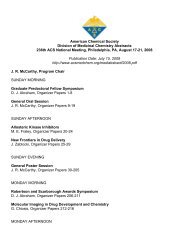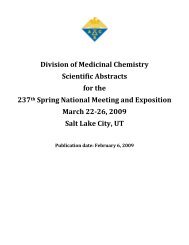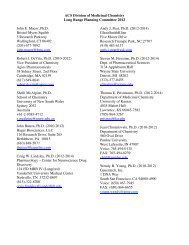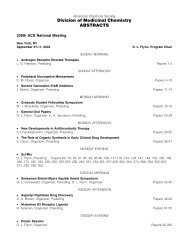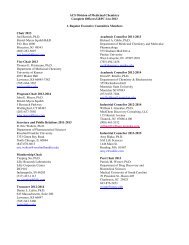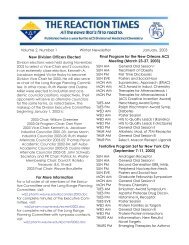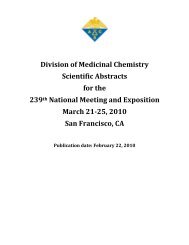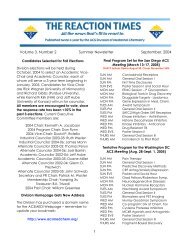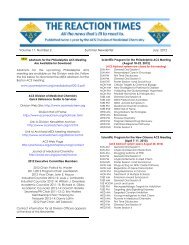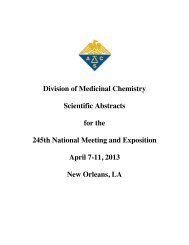Division of Medicinal Chemistry Abstracts-235th ACS National ...
Division of Medicinal Chemistry Abstracts-235th ACS National ...
Division of Medicinal Chemistry Abstracts-235th ACS National ...
- No tags were found...
You also want an ePaper? Increase the reach of your titles
YUMPU automatically turns print PDFs into web optimized ePapers that Google loves.
MEDI 82<br />
Synthesis and SAR <strong>of</strong> 1,2,3,4-tetrahydro-pyrido[2,3-b]pyrazines as c-Met and ALK<br />
inhibitors<br />
Linda R. Weinberg 1 , Mark S. Albom 2 , Thelma S. Angeles 2 , Bruce D. Dorsey 1 , Jean Husten 2 ,<br />
Karen L. Milkiewicz 1 , Seetha Murthy 2 , Douglas A. Pippin 1 , Renee Roemmele 3 , and Ted L.<br />
Underiner 1 . (1) Department <strong>of</strong> <strong>Medicinal</strong> <strong>Chemistry</strong>, Cephalon, Inc, 145 Brandywine Parkway,<br />
West Chester, PA 19380, lweinber@cephalon.com, (2) Department <strong>of</strong> Lead Discovery and<br />
Pr<strong>of</strong>iling, Cephalon, Inc, West Chester, PA 19380, (3) Department <strong>of</strong> Chemical Process<br />
Research and Development, Cephalon, Inc, Malvern, PA 19355<br />
Dysregulation <strong>of</strong> c-Met and ALK kinases are implicated in a variety <strong>of</strong> cancers. c-Met plays a<br />
key role in the proliferation, survival, motility, invasion and metastasis <strong>of</strong> cancer cells. Activation<br />
<strong>of</strong> c-Met is implicated in the genesis <strong>of</strong> papillary renal carcinomas, gastric CA and subsets <strong>of</strong><br />
osteo-s<strong>of</strong>t sarcomas. Chromosomal translocations generate multiple ALK oncogenic fusion<br />
proteins in tumors. The NPM-ALK and EML4-ALK proteins play a causative role in the<br />
pathogenesis <strong>of</strong> anaplastic large-cell lymphoma and non-small cell lung cancer, respectively.<br />
Starting from a Sugen/Pfizer c-Met/ALK dual inhibitor, chemistry was developed to rapidly<br />
elaborate the SAR around a pyridopyrazine scaffold. Analogs from this series were identified<br />
that inhibit c-Met and/or ALK enzyme with IC50 values less than 100 nM. The kinase inhibitory<br />
activity was dependent upon the nature <strong>of</strong> the X, R and Ar groups.<br />
MEDI 83<br />
Targeted binding <strong>of</strong> chitosan-based nanoparticles with galactose ligand to HepG2 cells<br />
Ting Wang, Zhangqi Feng, Wenjing Yang, and Nongyue He, State Key Laboratory <strong>of</strong><br />
Bioelectronics, Southeast University, Si Pai Lou 2, 210096 Nanjing, China, Fax: 86-25-<br />
83790885, echo2165@163.com, ywjzfh@163.com, nyhe1958@163.com<br />
Solid core-shell polymeric particles are attractive delivery vehicles, because they can efficiently<br />
encapsulate drugs <strong>of</strong> different physical and chemical characteristics. However, target-tracking<br />
particles for therapeutic purposes have been a somewhat elusive question. In this study we<br />
developed chitosan-based nanoparticles with galactose ligand which has special response<br />
activity with asialoglycoprotein (ASGPR) receptor in the surface carbohydrate <strong>of</strong> HepG2 cells.<br />
First the chitosan-200 (CS) was modified by lactose acid (LA) to synthesize galactose<br />
conjugated chitosan (Gal-CS) which was detected by FITR and 1H-NMR, the results showed<br />
that the degrees <strong>of</strong> substitution <strong>of</strong> LA coupled with chitosan-200 was about 17.6 mol%, then the



